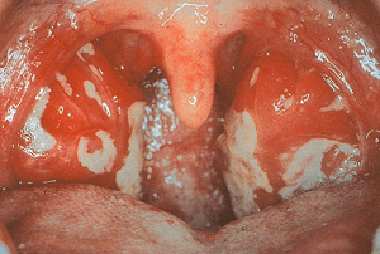Infectious diseases >>>> What is Mononucleosis?
What is Mononucleosis?

Mononucleosis is an acute infectious disease of viral etiology that affects the oropharynx, lymph nodes, spleen, liver and changes the composition of the blood (atypical mononuclear cells appear - these are altered cells of lymphocytes that have become similar to monocytes). The disease has several names: infectious mononucleosis, monocytic tonsillitis, Filatov disease.
The causative agent of the infection is a virus from the herpesviridae family, called the Epstein-Barr virus (Epstein-Barr). As a rule, infection with this virus occurs in childhood or adolescence from a person with an erased or manifest form of the disease. The virus is transmitted with saliva when kissing children from adults, or to each other. In addition, the Epstein-Barr virus is transmitted through blood transfusions and / or bone marrow transplants. People with weakened immune systems (including HIV patients) are especially vulnerable to infection.

Penetrating into the oral cavity with saliva, the virus begins to multiply in the epithelial cells of the oropharynx, and also penetrates the lacunae of the tonsils. Upon contact with epithelial cells, B-lymphocytes become infected, and the virus, entering the bloodstream, spreads throughout the body. Infection of B-lymphocytes and clones of T-lymphocytes leads to proliferation of lymphocytes in the region of the lymph nodes (hyperplasia of lymphoid tissue). The incubation period of mononucleosis lasts from one to one and a half months.
Signs of infectious mononucleosis:
- Within one to two weeks, the state of health changes: weakness, fatigue appears, attention decreases;
- Chills appear;
- Headaches;
- Myalgia ;
- A sore throat develops;
- Signs of dyspepsia, vomiting may occur ;
- Examination reveals enlarged lymph nodes, signs of tonsillitis (swelling of the tonsils, plaque on them), rashes in the palate, a skin rash or erythematous rash is possible;
- The temperature rises and can be kept for two weeks - a month;
- Sometimes splenomegaly (enlarged spleen) and / or hepatomegaly (enlarged liver) develop.
A characteristic feature of the disease is its prolonged course with periods of exacerbations and remissions, which delays the overall course of the disease in some cases up to one and a half years.
In an adult, it can proceed without signs of sore throat, changes and other specific symptoms, but general malaise and myalgia remain. Mononucleosis is rare in babies.
Laboratory diagnostics confirms infectious mononucleosis by the presence of altered lymphocytes in the blood (lymphocytosis), thrombocytopenia, and changes in the biochemical parameters of the liver. Oropharyngeal washings are not performed to isolate and confirm the presence of the virus.
Treatment for infectious mononucleosis is usually done at home:
- For health reasons, bed rest is indicated,
- A sparing diet that does not burden the liver (exclude fried, fatty foods, seasonings), drink plenty of fluids,
- No specific therapy is required, with the exception of treating the oropharynx and tonsils with antiseptic agents, rinsing with antiseptic solutions,
- Antibiotics are prescribed only in cases with an attached bacterial infection (this is considered a complication of infectious mononucleosis),
- With severe swelling of the pharynx and the threat of asphexia, a course of corticosteroids is prescribed to relieve inflammation (for example, prednisone),
- With a deterioration in general well-being and to maintain the immune system (it is she who will fight the virus), it is possible to use immunostimulants under the supervision of a doctor.
Infectious mononucleosis does not require special treatment and goes away on its own, like most viral respiratory diseases. It is believed that about 90% of the adult population has already had some form of infectious mononucleosis and has antibodies to the Epstein-Barr virus, so it is generally accepted that infectious mononucleosis is a disease of the young population.
Sometimes the course of the disease passes with complications when the CNS virus is damaged, the addition of a bacterial infection, obstruction of the upper respiratory tract, and edema of the epiglottis. Very rarely occurs hepatitis, pneumonia with effusion, pericarditis or myocarditis, vasculitis, rupture of the spleen.

Read

Read



























